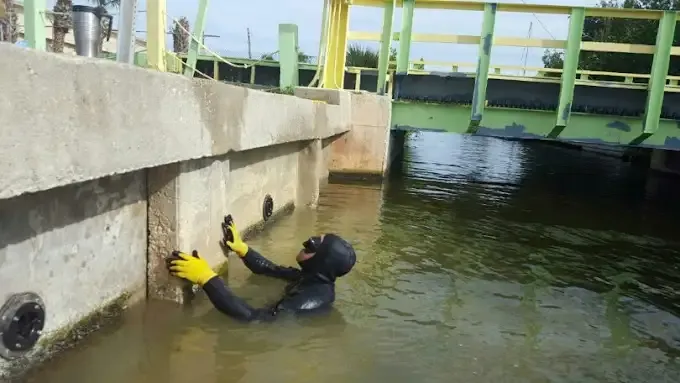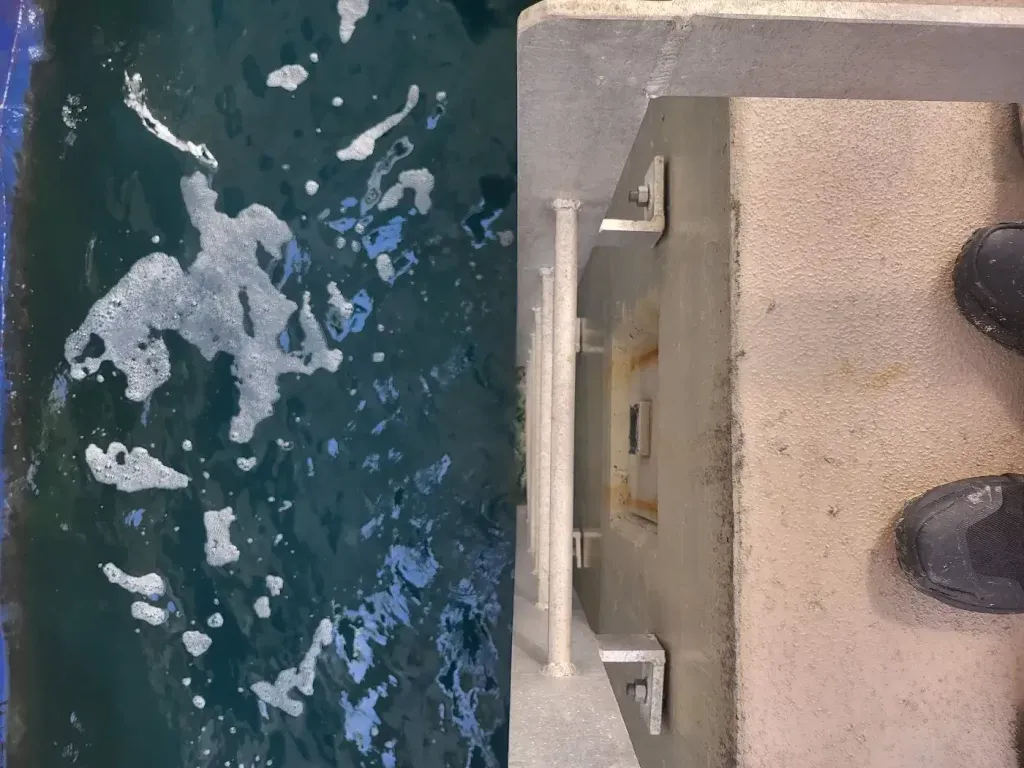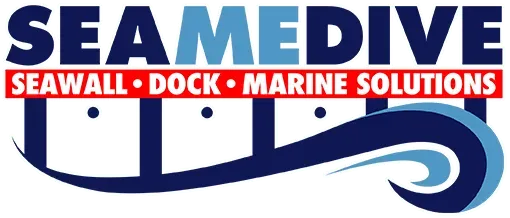Concrete seawalls are essential structures that protect properties from erosion, flooding, and the damaging effects of water pressure. Over time, these walls can degrade, especially in areas with high boat traffic, king tides, and extreme weather conditions. In South Florida, where seawalls face unique challenges due to the region’s intercoastal waters and active marine environment, Concrete Seawall Repair using Jet Filters has emerged as the most effective and reliable solution.

At Sea Me Dive, we specialize in marine construction and commercial diving, and we’ve been at the forefront of seawall repair technology for over 20 years. Among the products we use, the Jet Filter stands out as a bulletproof solution that’s simple, effective, and easily maintained. Whether you’re in Fort Lauderdale, Miami, or anywhere in South Florida, this method ensures your seawall remains strong and functional for years to come.
This blog post will explore the best approach to Concrete Seawall Repair using JET Filter, particularly in areas like Concrete Seawall Repair in South Florida, and discuss why it’s a preferred method for marine contractors and property owners.
Why are Jet Filters the Ultimate Solution for Concrete Seawall Repair?
JET Filter systems offer a proactive approach to managing hydrostatic pressure. These systems are designed to equalize the pressure between the land and the waterway by allowing water to discharge freely without sacrificing soil compaction. Unlike traditional weephole systems, often consisting of simple PVC pipes with cloth backing, JET Filters are far more advanced and effective.
Water pressure from the land side is the primary enemy of seawalls. During Florida’s rainy season or low tides, this pressure builds up and can cause the structure to cave in, leading to costly repairs or replacements. The Jet Filter acts as a savior by allowing water to discharge from the land side to the waterway without losing soil compaction. This equalizes the pressure between the land and the water, preventing structural damage.
The Process of Concrete Seawall Repair Using Jet Filter
At Sea Me Dive, we’ve perfected the installation process for Jet Filters, ensuring optimal results for every project. Here’s a step-by-step breakdown of how we do it:
1. Preparation of the Seawall Surface
Before installing the Jet Filter, it’s essential to prepare the seawall surface. The wall surface needs to be properly prepared. This may involve jet cleaning with a 5000 psi pressure washer to remove marine growth and debris. Any spalling or damaged areas should be repaired with hydraulic concrete fairing to create a smooth, even surface. According to our owner, Alon Beilis, proper prep is important because you want to make sure the flange on the filter sits evenly on the surface and doesn’t allow water to leak from the outside of the filter mound flange.
Depending on the type of seawall, this process may vary:
- Concrete Panel Walls: We use a 5000 psi pressure washer to clean the surface thoroughly. If there is spalling or broken areas, we use hydraulic concrete to flatten the surface.
- Coral Rock Walls: These require hydraulic concrete to ensure a smooth surface.
- Vinyl or Aluminum Walls: If the walls are new and free of fouling, minimal preparation is needed.
The goal is to ensure the flange of the Jet Filter sits evenly on the surface, preventing water leakage around the edges.
2. Core Drilling
Once the surface is prepared, we mark the areas where the Jet Filters will be installed. Using a spacer board, we ensure the filters are placed slightly above the growth line to prevent debris from entering the cartridge.
Our team uses core drills to create precise holes in the seawall. The drill is held perpendicular to the wall to maintain a 90-degree angle during the process. After penetrating the wall, we remove the core and clean the interior to ensure a smooth fit for the Jet Filter.
3. Anchoring the Jet Filter
Next, we mark and drill four pilot holes for the anchors. We use stainless steel mushroom anchors, which are strong and durable, especially in high-impact areas like the intercoastal waters of Fort Lauderdale and Miami. These anchors are driven into the holes in a diagonal pattern, ensuring the flange compresses evenly against the seawall panel.
4. Installing the Jet Filter
The Jet Filter cartridge is then placed into the core hole. The one-way valve system allows water to discharge from the land side to the waterway while preventing water from entering the property during high tides or storms. The stainless steel louvered vent protects the bladder of the seal from wave impacts, making it ideal for seawalls in active marine environments.
Choosing the Right JET Filter System
The type of JET Filter system best suited for a particular seawall depends on several factors, including the wall’s construction, the surrounding environment, and the level of wave action. For example, in areas with heavy boat traffic and significant wake, like the Intracoastal, a filter with a one-way valve and a stainless steel louvered vent is recommended to protect the valve bladder from wave impact. Beilis chose the 4-inch system for a panel tunnel tongue and groove wall on the Intracoastal because of heavy boat traffic. Consulting with a qualified marine contractor is essential for determining the appropriate JET Filter system for your specific needs. You should consider Sea Me Dive.
Benefits of Jet Filter Systems in South Florida
- Prevents Hydrostatic Pressure Damage
By equalizing the pressure between the land and the water, the Jet Filter protects your seawall from collapse during Florida’s rainy season and king tides. - Durable and Low Maintenance
Made from high-quality materials, the Jet Filter is designed to withstand harsh marine conditions. Maintenance is simple and can be completed in minutes, ensuring the system remains effective year after year. - Pressure Equalization: JET Filters provide a controlled and efficient pathway for water to escape, reducing the hydrostatic pressure on the seawall.
- Soil Retention: The filter design prevents soil erosion, ensuring the stability of the backfill and surrounding landscape.
- Prevention of Rising Waters: The filter includes a one-way valve to prevent water from flowing backward into the property during high tides or storm surges, a significant concern in Concrete Seawall Repair in South Florida due to frequent king tides.
- Durability and Longevity: Made with high-quality materials, JET Filters are built to withstand the harsh marine environment and provide years of reliable performance. Alon Beilis of Sea Me Dive has been using this technology for over 7 years and touts it as a “bulletproof” product.
- Minimal Maintenance: JET Filters are designed for easy inspection and cleaning, ensuring optimal performance with minimal effort.
- Versatile Application: JET Filters can be installed on new or existing seawalls, including concrete panel, coral rock, vinyl, and aluminum walls.

Applications of Jet Filters in Fort Lauderdale and Miami
In Fort Lauderdale, where boat traffic and wake impacts are significant, the Jet Filter has proven to be an ideal solution. The City of Fort Lauderdale has even incorporated this system into their new seawall projects, recognizing its effectiveness in high-impact areas.
Similarly, in Miami, where king tides and rising water levels are a growing concern, the Jet Filter provides a reliable way to protect properties from flooding and structural damage.
Maintenance Tips for Jet Filter Systems
Maintaining your Jet Filter system is straightforward and ensures it continues to function optimally:
- For composite units, simply pull out the cartridge, brush the inside and outside, and reinsert it.
- For units with stainless steel screws, remove the inner screws, clean the cartridge, and reinstall it.
- Regular maintenance removes debris from the louvered vent and ensures efficient water discharge.
Case Studies and Success Stories
The success of JET Filter systems is well-documented. The founder of Sea Me Dive, Alon Beilis mentions that Florida Water Management and the Army Corps of Engineers have also used the product. Numerous properties in South Florida, including those in Fort Lauderdale and Miami, have benefited from the installation of JET Filters, preventing costly seawall repairs and protecting valuable waterfront assets.
Why Choose Sea Me Dive for Your Concrete Seawall Repair Using Jet Filter?
With over seven years of experience installing Jet Filters, we’ve completed numerous projects across South Florida, earning the trust of clients and local governments alike. Our team of experts understands the unique challenges of seawalls in the intercoastal waters of Fort Lauderdale and Miami, and we tailor our solutions to meet your property’s specific needs.
Whether you’re dealing with concrete panel walls, coral rock walls, or other seawall types, we have the knowledge and technology to protect your investment.
Water can be both a friend and an enemy when it comes to seawalls. The Jet Filter system allows you to work with water rather than fight it, ensuring your seawall remains strong and functional for years to come. If you’re in South Florida and need Concrete Seawall Repair using a Jet Filter, contact Sea Me Dive today. Let us help you protect your property with the most advanced and effective solution available.
Concrete Seawall Repair using JET Filter systems is a proven and effective method for managing hydrostatic pressure and protecting seawalls from damage. By allowing water to discharge freely without sacrificing soil compaction, JET Filters offer a reliable and sustainable solution for extending the lifespan of your seawall.
Whether you’re dealing with a new seawall or an existing structure in need of repair, consulting with a qualified marine contractor and considering the benefits of JET Filter systems is a wise investment in the long-term health and value of your waterfront property. By choosing this technology, you’re not just repairing a seawall, you’re investing in a proactive and sustainable solution that protects your property and preserves the beauty of the waterfront environment.
